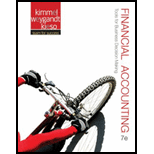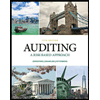
Financial Accounting
7th Edition
ISBN: 9781118162286
Author: Kimmel, Paul D.
Publisher: John Wiley & Sons Inc
expand_more
expand_more
format_list_bulleted
Question
Chapter 6, Problem 22Q
To determine
Inventory turnover ratio: This is a financial measure that is used to evaluate as to how many times a company sells or uses its inventory during an accounting period. It is calculated by using the following formula:
To Explain: The circumstances under which inventory turnover will be too high, and its consequences.
Expert Solution & Answer
Want to see the full answer?
Check out a sample textbook solution
Students have asked these similar questions
PART 2.
(22 marks)
Mangal Furnishings produce serving trays for the tourist industry in a five-stage process - Cutting &
Shaping, Assembly, Sanding, Finishing and Packaging. Upon entering the finishing process, before
the trays are stained and polished, a specialized piece of equipment is used to engrave a logo on
each tray. After Packaging, the trays are sent to the business warehouse for delivery to customers.
The following data relates to the Finishing Process for the month of March during which 3,800 trays
valued at $597.90 each were transferred in from the Sanding Process.
Other production costs incurred during the month are summarized as follows:
Direct Materials Added
Direct Manufacturing Wages
Hireage cost of specialized logo equipment
Manufacturing Overhead
$343,380
$830,150
$21,300
$412,100
Process inspection occurs during the process and normally 2% of the trays entering the Finishing
process are rejected and sold as scrap to local retailers at $750 each. During the month…
Cline Manufacturing Company uses a job order system and maintains perpetual inventory records.
Indicate the the appropriate account(s) to be debited and credited for the transactions listed below. (On multiple entries enter
answers in alphabetical order.)
Transactions
1.
Raw materials were purchased on account.
2.
Issued a check to Dixon Machine Shop for repair
work on factory equipment.
3.
Direct materials were requisitioned for Job 280.
4.
Factory labor was paid as incurred.
5.
Recognized direct labor and indirect labor used.
6.
The production department requisitioned
7.
indirect materials for use in the factory.
Manufacturing overhead was applied to
production based on a predetermined overhead
rate of $8 per labor hour.
8.
Goods that were completed were transferred to
finished goods inventory.
9.
Goods costing $80,000 were sold for $105,000
on account.
10.
Paid for raw materials purchased previously on
account.
Account(s)
Debited
Based on the screenshot, what is the maximim flow?
Chapter 6 Solutions
Financial Accounting
Ch. 6 - The key to successful business operations is...Ch. 6 - Prob. 2QCh. 6 - What is just-in-time inventory management? What...Ch. 6 - Prob. 4QCh. 6 - Prob. 5QCh. 6 - Prob. 6QCh. 6 - Prob. 7QCh. 6 - Prob. 8QCh. 6 - What is the major advantage and major disadvantage...Ch. 6 - The selection of an inventory cost flow method is...
Ch. 6 - Which assumed inventory cost flow method: (a)...Ch. 6 - Prob. 12QCh. 6 - Prob. 13QCh. 6 - Prob. 14QCh. 6 - Prob. 15QCh. 6 - Prob. 16QCh. 6 - Prob. 17QCh. 6 - Prob. 18QCh. 6 - Prob. 19QCh. 6 - Why is it inappropriate for a company to include...Ch. 6 - Prob. 21QCh. 6 - Prob. 22QCh. 6 - Prob. 23QCh. 6 - When perpetual inventory records are kept, the...Ch. 6 - How does the average-cost method of inventory...Ch. 6 - Prob. 26QCh. 6 - Prob. 6.1BECh. 6 - Prob. 6.2BECh. 6 - Prob. 6.3BECh. 6 - Prob. 6.4BECh. 6 - Prob. 6.5BECh. 6 - Prob. 6.6BECh. 6 - Prob. 6.7BECh. 6 - Prob. 6.8BECh. 6 - Prob. 6.9BECh. 6 - Prob. 6.10BECh. 6 - Prob. 6.11BECh. 6 - Do It! 6-1 Dobler Company just took its physical...Ch. 6 - Prob. 6.2DIRCh. 6 - Prob. 6.3DIRCh. 6 - Prob. 6.4DIRCh. 6 - E6-1 Columbia Bank and Trust is considering giving...Ch. 6 - E6-2 Kevin Farley, an auditor with Koews CPAs, is...Ch. 6 - Prob. 6.3ECh. 6 - E6-4 Delmott sells a snowboard, Xpert, that is...Ch. 6 - Prob. 6.5ECh. 6 - E6-6 On December 1, Quality Electronics has three...Ch. 6 - Prob. 6.7ECh. 6 - Prob. 6.8ECh. 6 - Prob. 6.9ECh. 6 - Prob. 6.10ECh. 6 - Prob. 6.11ECh. 6 - Prob. 6.12ECh. 6 - Prob. 6.13ECh. 6 - Prob. 6.14ECh. 6 - Prob. 6.15ECh. 6 - Prob. 6.1APCh. 6 - Prob. 6.2APCh. 6 - Prob. 6.3APCh. 6 - Prob. 6.4APCh. 6 - Prob. 6.5APCh. 6 - Prob. 6.6APCh. 6 - Prob. 6.7APCh. 6 - Prob. 6.8APCh. 6 - Prob. 6.9APCh. 6 - Prob. 6.1BPCh. 6 - Prob. 6.2BPCh. 6 - Prob. 6.3BPCh. 6 - Prob. 6.4BPCh. 6 - Prob. 6.5BPCh. 6 - Prob. 6.6BPCh. 6 - Prob. 6.7BPCh. 6 - Prob. 6.8BPCh. 6 - Prob. 6.9BPCh. 6 - Prob. 1CPCh. 6 - Prob. 6.1BYPCh. 6 - Prob. 6.2BYPCh. 6 - The July 15, 2010, edition of CFO.com contains an...Ch. 6 - Prob. 6.4BYPCh. 6 - Prob. 6.6BYPCh. 6 - Prob. 6.7BYPCh. 6 - Prob. 6.8BYPCh. 6 - Prob. 6.9BYPCh. 6 - Prob. 6.10BYPCh. 6 - Prob. 6.1IFRSCh. 6 - Prob. 6.2IFRSCh. 6 - Prob. 6.3IFRSCh. 6 - Prob. 6.4IFRS
Knowledge Booster
Learn more about
Need a deep-dive on the concept behind this application? Look no further. Learn more about this topic, accounting and related others by exploring similar questions and additional content below.Similar questions
- Star Company incurred and paid the following costs for research and development activities: Material used from inventory $ 60,000 Wages and salaries 85,000 Allocation of general and administrative costs 25,000 Depreciation on building housing multiple research and development activities 30,000 Machine purchased for research and development project that has no future alternative uses 35,000 Total $235,000 If Star includes all these costs in research and development expense, including the entire cost of the machine with no alternative future uses, which of the following would be included in the journal entry?arrow_forwardForeign currency translation—Comprehensive income A U.S.-based parent company acquired a European Union–based subsidiary many years ago. The subsidiary is in the service sector, and earns revenues and incurs expenses evenly throughout the year. The following preclosing trial balance includes the subsidiary’s original Euros-based accounting information for the year ended December 31, 2022, immediately prior to closing the company’s nominal accounts into the corresponding balance sheet accounts. It also includes the information converted into $US based on the indicated exchange rates: $US Conversion Weighted- Debits (Credits) Euros Current Average Historical Monetary Assets € 120,000.00 $144,000 $147,600 $156,000 Nonmonetary assets 480,000 576,000 590,400 624,000 Monetary Liabilities (60,000) (72,000) (73,800) (78,000) Nonmonetary liabilities (300,000) (360,000) (369,000) (390,000) Contributed capital (144,000) (172,800) (177,120) (201,600) Retained…arrow_forwardTommys so books on leo July 21 year-end. The company does make eerless crue for Inverses ancage de ke year-end. On June 30, 2007, the Recall cours kolonce à 304,400 Now Reclude she folowing Dute Maker Face Value Tar Maturity Data R Apt C 85,000 90 day July 20 May 15 ya 7,000 July24 Car 10,000 December During Julhe following recom July Modes of $4,300 on Toorak edece 165700 un Vrede cord. The cred card recharge la 26. 20 Recall 24 (a) Journalize the July wonde July designery for ccrued in recevable coming 250 days for exams.com of goods sold edit account titles are automatically indented when amo Account Titles and Explanation Date Debit Credit Textbook and Media List of Accountaarrow_forward
- Foreign currency remeasurement—Total assets A U.S.-based parent company acquired a European Union–based subsidiary many years ago. The subsidiary is in the service sector, and earns revenues and incurs expenses evenly throughout the year. The following preclosing trial balance includes the subsidiary’s original Euros-based accounting information for the year ended December 31, 2022, immediately prior to closing the company’s nominal accounts into the corresponding balance sheet accounts. It also includes the information converted into $US based on the indicated exchange rates: $US Conversion Weighted- Debits (Credits) Euros Current Average Historical Monetary Assets € 180,000.00 $216,000 $221,400 $234,000 Nonmonetary assets 720,000 864,000 885,600 936,000 Monetary Liabilities (90,000) (108,000) (110,700) (117,000) Nonmonetary liabilities (450,000) (540,000) (553,500) (585,000) Contributed capital (216,000) (259,200) (265,680) (302,400) Retained earnings…arrow_forwardForeign currency remeasurement—Stockholders’ equity A U.S.-based parent company acquired a European Union–based subsidiary many years ago. The subsidiary is in the service sector, and earns revenues and incurs expenses evenly throughout the year. The following preclosing trial balance includes the subsidiary’s original Euros-based accounting information for the year ended December 31, 2022, immediately prior to closing the company’s nominal accounts into the corresponding balance sheet accounts. It also includes the information converted into $US based on the indicated exchange rates: $US Conversion Weighted- Debits (Credits) Euros Current Average Historical Monetary Assets € 160,000.00 $192,000 $196,800 $208,000 Nonmonetary assets 640,000 768,000 787,200 832,000 Monetary Liabilities (80,000) (96,000) (98,400) (104,000) Nonmonetary liabilities (400,000) (480,000) (492,000) (520,000) Contributed capital (192,000) (230,400) (236,160) (268,800) Retained…arrow_forward? ? Financial accounting questionarrow_forward
- The income statement of a merchandising company includes Cost of Goods Sold (COGS) and gross profit, which are not found on a service company’s income statement. This is because merchandising companies sell physical products, while service companies provide intangible services. Service company income statements are simpler, usually showing revenue from services minus operating expenses like salaries, rent, and supplies. In short, the main difference is that merchandising firms track product costs and gross profit, while service companies do not. Respond to this post. agree or disagreearrow_forwardPlease give me true answer this financial accounting questionarrow_forwardI need this question financial accountingarrow_forward
arrow_back_ios
SEE MORE QUESTIONS
arrow_forward_ios
Recommended textbooks for you
- Principles of Accounting Volume 1AccountingISBN:9781947172685Author:OpenStaxPublisher:OpenStax College
 Intermediate Financial Management (MindTap Course...FinanceISBN:9781337395083Author:Eugene F. Brigham, Phillip R. DavesPublisher:Cengage Learning
Intermediate Financial Management (MindTap Course...FinanceISBN:9781337395083Author:Eugene F. Brigham, Phillip R. DavesPublisher:Cengage Learning
 Intermediate Accounting: Reporting And AnalysisAccountingISBN:9781337788281Author:James M. Wahlen, Jefferson P. Jones, Donald PagachPublisher:Cengage Learning
Intermediate Accounting: Reporting And AnalysisAccountingISBN:9781337788281Author:James M. Wahlen, Jefferson P. Jones, Donald PagachPublisher:Cengage Learning Auditing: A Risk Based-Approach (MindTap Course L...AccountingISBN:9781337619455Author:Karla M Johnstone, Audrey A. Gramling, Larry E. RittenbergPublisher:Cengage Learning
Auditing: A Risk Based-Approach (MindTap Course L...AccountingISBN:9781337619455Author:Karla M Johnstone, Audrey A. Gramling, Larry E. RittenbergPublisher:Cengage Learning Cornerstones of Cost Management (Cornerstones Ser...AccountingISBN:9781305970663Author:Don R. Hansen, Maryanne M. MowenPublisher:Cengage Learning
Cornerstones of Cost Management (Cornerstones Ser...AccountingISBN:9781305970663Author:Don R. Hansen, Maryanne M. MowenPublisher:Cengage Learning

Principles of Accounting Volume 1
Accounting
ISBN:9781947172685
Author:OpenStax
Publisher:OpenStax College

Intermediate Financial Management (MindTap Course...
Finance
ISBN:9781337395083
Author:Eugene F. Brigham, Phillip R. Daves
Publisher:Cengage Learning


Intermediate Accounting: Reporting And Analysis
Accounting
ISBN:9781337788281
Author:James M. Wahlen, Jefferson P. Jones, Donald Pagach
Publisher:Cengage Learning

Auditing: A Risk Based-Approach (MindTap Course L...
Accounting
ISBN:9781337619455
Author:Karla M Johnstone, Audrey A. Gramling, Larry E. Rittenberg
Publisher:Cengage Learning

Cornerstones of Cost Management (Cornerstones Ser...
Accounting
ISBN:9781305970663
Author:Don R. Hansen, Maryanne M. Mowen
Publisher:Cengage Learning
Accounting Changes and Error Analysis: Intermediate Accounting Chapter 22; Author: Finally Learn;https://www.youtube.com/watch?v=c2uQdN53MV4;License: Standard Youtube License